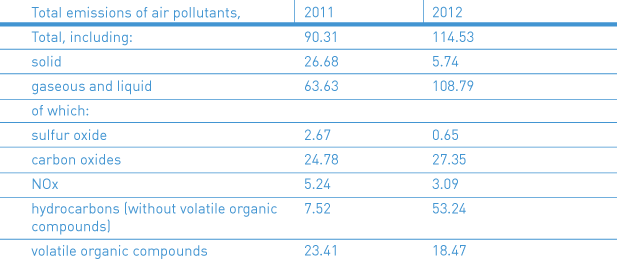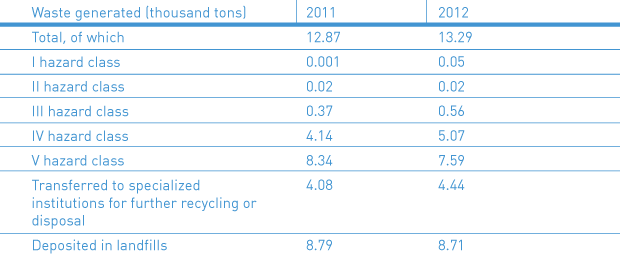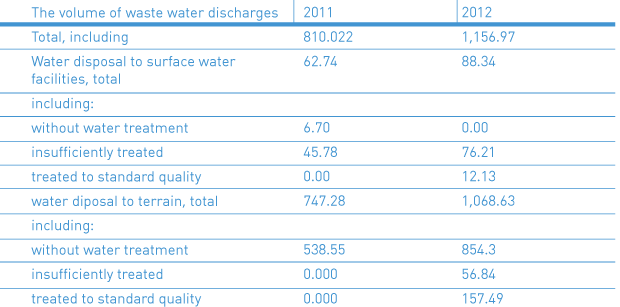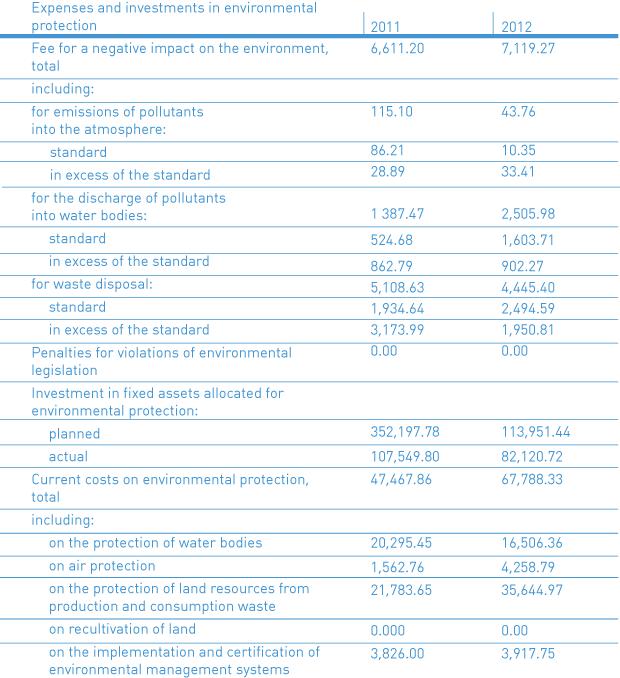- Statement of the Chairman of the Management Board
- Federal Grid Company General Information
- Corporate Governance
- Internal Control System
- The Risk Management System
- Understanding of Corporate Social Responsibility and Sustainable Development
- Human Resources Management
- Managing of the Economic Impact
-
Anti-corruption and Prevention of Conflict of Interests System
- JSC Federal Grid Company`s Anti-Corruption Policy
- Program for Prevention of Corruption and Settlement of Conflict of Interests in Federal Grid Company for 2012-2014
- Implementation of Anti-Corruption Policy and Program for Anti-corruption and Settlement of Conflict of Interests in Federal Grid Company in 2012
- 2013 Plans
- Environmental Impact Management
- Stakeholders Relations
-
APPENDICES
- The UNEG Reliability Provisions
- Innovative Development of the UNEG
- GRI Guidelines Indicators (G 3.1 and the Industry Protocol for Electric Power Industry), Reflected in the Report
- A Report on the Fulfillment of the 2012 CSR Plans and Obligations of JSC FGC UES (Draft)
- A Table of Stakeholders’ Suggestions Pertaining to the Disclosure of Information in the Report, Voiced at the Dialogue on 05.04.2013 and at the Public Hearings on 26.04.2013
- A List of Natural Areas in Preferential Protection (NAPP) Accessible for JSC FGC UES for the Purposes of Operation
- Independent Assurance of Social Reporting
- Glossary and Abbreviations
Key Indicators of the Environmental Impact
Emissions into the atmosphere of pollutants
Transmission of electricity as core activity of Federal Grid Company has a much lower impact on the environment in comparison with other sectors of electric power industry.
Power grids specifics related to environmental impact is that emissions, discharges and waste are not the result of the production process, but arise from general economic activity and are characterized by a very low level relative to the maximum permissible values.
In 2012, Federal Grid Company`s indicators of negative impact on the components of the environment were:
- — the total amount of emissions into the atmosphere — 114.7 tons;
- — the volume of discharges to surface water bodies — 88.34 thousand m3;
- — the amount of I-IV hazard class waste generated — 13.3 thousand tons.
In the process of production activity Federal Grid Company uses gas-insulated equipment equipped with accidental release sensors. By that the Company doesn`t keep account of the volume of sulfur hexafluoride added to the equipment in the event of losses. Under the terms of the International Electrotechnical Commission (IEC) sulfur hexafluoride leakage may be up to 0.5% per year.
In 2012, there were no relevant transformer oil spills.
Transportation of materials and employees to organize and execute works is carried out at short distances and does not have significant impact on the environment.
Indirect emissions of greenhouse gases in the activities of the Company are formed by the loss in power grids and electricity consumption for own needs of substations.
In 2012 equivalent emissions of CO2 that corresponds to power losses in Federal Grid Company`s grids and electricity consumption for own needs was 11,712.35 thousand tons. In 2011, this indicator was 12,055.93 thousand tons*. Other relevant indirect greenhouse gases emissions are absent.
Ozone-depleting substances are absent in the Company's emissions.
Air Emissions of NOx, SOx and Other Relevant Pollutants by Type and Weight, tons

Total emissions of pollutants into the atmosphere in 2012 increased due to an increase in emissions of gaseous and liquid pollutants into the atmosphere, which in turn is driven by the valuation of a significant number of stationary emission sources (transformers, welding stations, garages, workshops, etc.) which have not been included before in the draft emission limits and considered in the overall calculation.
Generation of waste
Quantitative indicators of waste generation are presented in the table "Total weight of waste by type and disposal method".
Total Weight of Waste by Type and Disposal Method

Total volume of waste of I-IV hazard classes generated in 2012 increased slightly compared with 2011. However, it should be noted that in 2012, the amount of waste deposited in landfills decreased due to growth in the amount of waste transferred for recycling or disposal.
The Company's enterprises in conducting its activities do not transport, import or export waste. All types of waste generated from production activities of the Company are transferred to specialized organizations which operate in the territory of the Russian Federation for further recycling, utilization or final disposal.
The main condition to conclude contracts with contractors that accept the Company`s waste is that they have a license for decontamination and waste disposal issued by the authorities of the Federal Service for Supervision of Natural Resources that meets the requirements of applicable environmental legislation. Certification for compliance with the International Standard ISO 14001 in the Russian Federation is a voluntary procedure and, according to the Company’s managers, requirement for contractors to have international certificate is redundant.
In addition, in the processes associated with the reception, transmission and distribution of electricity the Company`s enterprises do not use recycled waste and reuse waste, except for reuse of refined transformer oil.
However, the volume of oil reused in total amount of waste generated at the Company's enterprises is very insignificant, so in 2012 it was 0.32%. Federal Grid Company has not produce any products which should be packaged therefore the Company does not use packaging materials.
Electromagnetic effect
Health standards and regulations adopted in the Russian Federation contain stringent standards on the influence of electric and magnetic fields on biological objects. The basic principle to protect public health against electromagnetic fields of power transmission lines is to establish sanitary protection zones (SPZ) and roadside clear zones for UNEG facilities.
The size of buffer zones are defined in accordance with the sanitary-epidemiological norms of permissible noise levels, electromagnetic radiation and other physical factors at the external boundary of the sanitary protection zone. All the Company`s facilities are designed, built and operated in full compliance with the SanPiN 2.2.1/2.1.1.1200-03 "Sanitary protection zones and sanitary classification of enterprises, buildings and other facilities. New edition". This SanPiN defined boundaries of sanitary protection zones for high-voltage lines (HV lines):
- 20 m for the 330 kV HV line;
- 30 m for the 500 kV HV line;
- 40 m for the 750 kV HV line;
- 55 m for the 1150 kV HV line. 40 ì äëÿ ÂË íàïðÿæåíèåì 750 êÂ;
- 55 ì äëÿ ÂË íàïðÿæåíèåì 1150 êÂ.
For the substations under construction and reconstruction SPZ boundaries are defined in the design documentation.
The impact on flora and fauna, soil and ground
The medium-term program on the implementation of Environmental Policy of JSC Federal Grid Company provides for including the introduction of environmentally friendly technologies for the transmission of electricity, reducing the burden on the environment:
- — the use of tapered multi-faceted steel poles instead of lattice to save occupied land space that is especially important in case of route of lines on protected areas;
- — construction of underground cable lines to free up land, preserve the existing land space and avoid negative impacts on the environment;
- — the use of gas-insulated switchgears (GIS), which are placed in enclosed buildings, that significantly reduces its impact on the environment and saves land space occupied by the substations;
- — full automated technological processes to operate power facilities, which allow remote service of facilities and excludes the necessity to construct water pipeline, canalization and waste utilization.
Electric grid companies have impact on the state of the vegetation mainly in constructing power lines, when cutting glades in a wooded land and clearing vegetation along power transmission lines.
Clearing vegetation along power transmission lines is performed manually, mechanically and with the use of herbicides permitted for use in the Russian Federation which do not have a negative impact on the environment.
Chemical means of clearing will not apply in specially protected areas and in water protection zones.
In 2012, the amount of clearance was as follows:
- — manual clearing – 28,613.0 ha;
- — mechanized clearing – 6,701.9 ha;
- — chemical clearing – 4,464.0 ha.
Branches of Federal Grid Company carry out recovery of vegetation and terrain in accordance with the re-cultivation of disturbed soil projects. In particular, as part of construction of facilities of the 2012 Olympic Games in Sochi a joint protocol to conserve ecosystems in the Mzymta river basin was signed between the main organizations-participants of construction. Federal Grid Company takes measures to protect the cable line and technological road to the Mzymta substation from mudflow masses with the use of "McCaffery" gabions overlaid on the adjacent slope and construct gabions and mudflow galleries.
In December 2012 compensatory measures for the removal of topsoil for the Mzymta substation on the territory of the Sochi National Park were executed. It includes the recovery of Sochi administration costs on execution of work under the plan to restore ecosystem of the Sochi National Park disturbed in the course of construction of Olympic facilities.
In most cases, compensatory measures are carried out at the end of construction, reconstruction and modernization of the power grid facilities. Compensatory measures are provided for in the design documentation. Issues of designing, construction, reconstruction and modernization in the Company are within the competence of the subsidiary JSC TZIUS UES.
Completed facilities are transferred to Federal Grid Company for operation only after all compensatory measures provided for in the project documentation are executed, but this information is not available to environmentalists of the branches of Federal Grid Company.
JSC TZIUS UES does not keep statistics on all executed compensatory measures.
Federal Grid Company takes necessary measures to reduce the impact of power grid facilities on the species composition of animals. The Company`s Technical Policy provides for the following measures:
- — the use of self-supporting insulated and protected wires to avoid bird deaths;
- — performance of measures at the power grid facilities to protect wildlife (equipment of HV lines` towers with special devices to prevent birds nesting on the structural elements of the towers and the use of deterrents and bird control devices, etc.).
It should be noted that the total number of species listed in the IUCN Red List and national conservation species list habitats of which are in specially protected areas affected by operations of the Company is 156 species including plants - 62 species, mushrooms - 3 species and animals - 91 species.
At present, the Company keeps statistics on birds / animals deaths only on the cases that led to blackouts and other technological disturbances. Given the large number of remote production facilities and the overall significant length of the Company`s grid today it is not possible to keep full statistics on bird deaths.
The Department of the implementation of environmental policy plans in 2013 to introduce mandatory reporting for the Company's branches on activities aimed at protecting wildlife.
The usage of water
Federal Grid Company`s enterprises` discharges and runoffs to water bodies are insignificant and have not significant impact on the biodiversity of water objects.
The usage of recycling water is used at several substations of the Company. 400 kV Vyborgskaya substation is equipped with the largest water recycling system with volume of 4.85 thousand m3.
Total volume of reusable water at the Company in 2012 was 27.5 million m3, which exceeds more than 20 times the total volume of water used for household and drinking and industrial needs.
Total Water Withdrawal by Source, thousand m3

Total Water Discharge Indicating the Quality of Waste Water and the Receiving Facility, thousand m3

The growth of total discharges is due to an increase in precipitation in 2012 and disposal of it to terrain.
The decline in water consumption compared with 2011 due to the implementation of measures for maintenance, repair and reconstruction of water supply facilities in the branches of federal Grid Company - MES and PMES. In addition the Company`s enterprises have no significant impact on water sources used. Representatives of the environmental community the Company`s impact was assessed as negligible.
Environmental protection costs
Total Costs and Investments in Environmental Protection, by Types, RUR thousand

Fee for a negative impact on the environment as a whole for Federal Grid Company in 2012 increased due to the commissioning of new facilities, standardization of new previously unrecorded sources of emissions and discharges. However, it should be noted a significant reduction in fees in excess of the standards by 38% compared to 2011, resulted from the receipt of necessary permits for almost all branches of the Company.
Environmental development
Staff Training Center of the branch of Federal Grid Company — MES North-West was recognized winner of the All-Russian competition for environmental development and energy efficiency GreenAwards in the category "Green Office: up to 2 thousand sq. m.".
The competition results were announced at the VI International Investment Forum on Real Estate PROEstate 2012 in St. Petersburg. Sustainable development of territory, energy efficiency, efficient use of water, materials and resources, internal environment quality, innovations in design, specific characteristics and creation of the conditions for alternative modes of transportation (bikes, etc.) were the main criteria for selection in the category «Green Office: up to 2 thousand sq. m.».
GreenAwards competition is held annually since 2007. Its main goal is to spread the successful experience in design and implementation of resource-efficient and environmentally friendly projects in Russia and the public recognition of the contribution of builders, developers and architects in the development of "green" construction.

 square km
square km